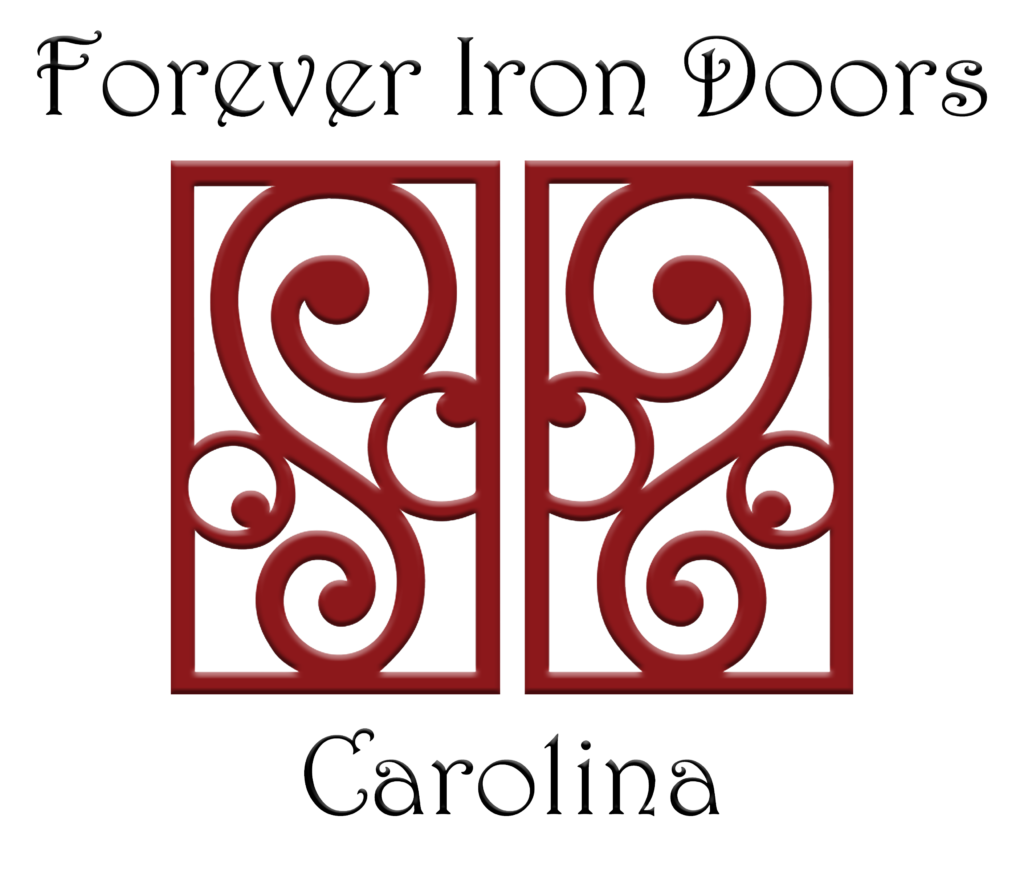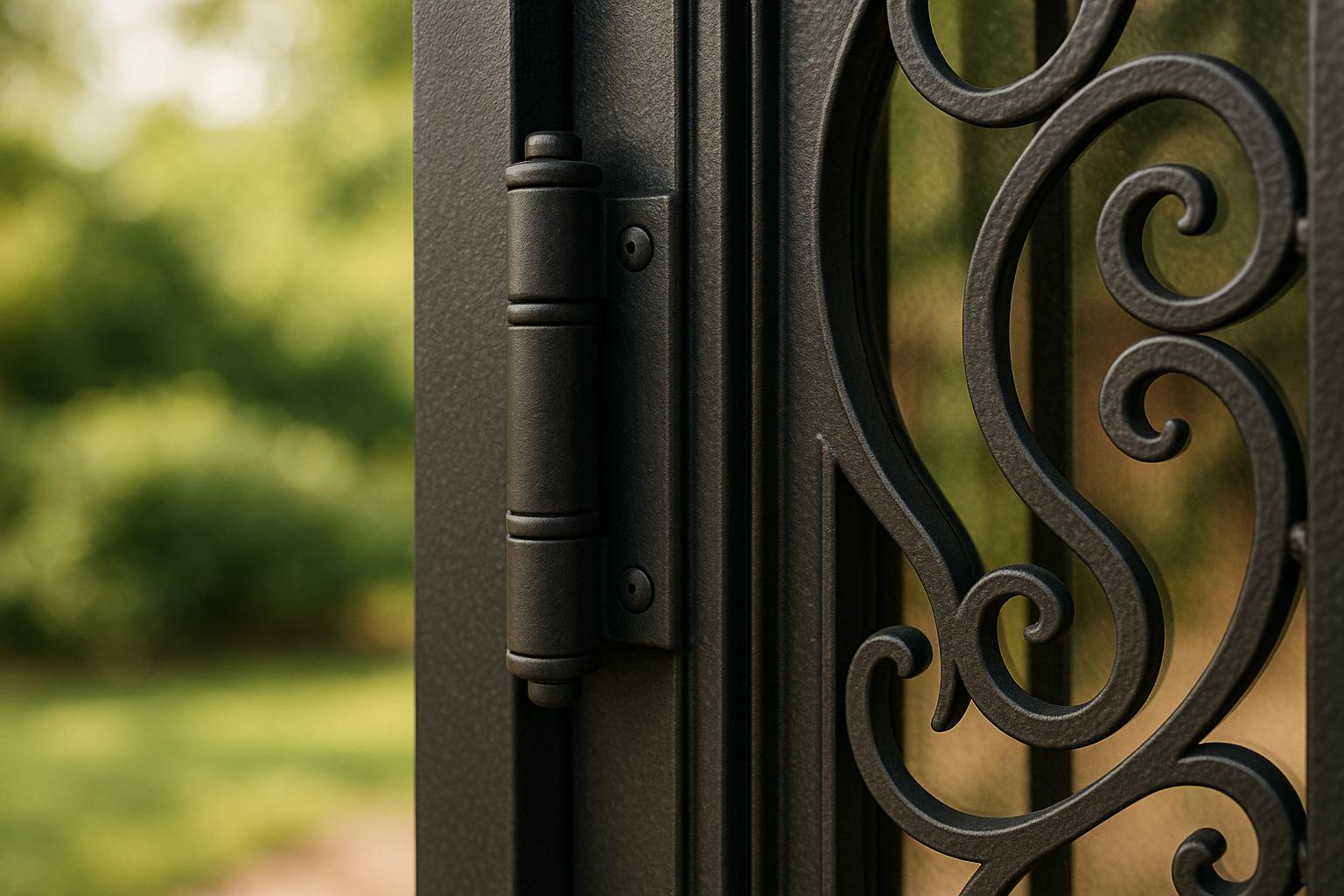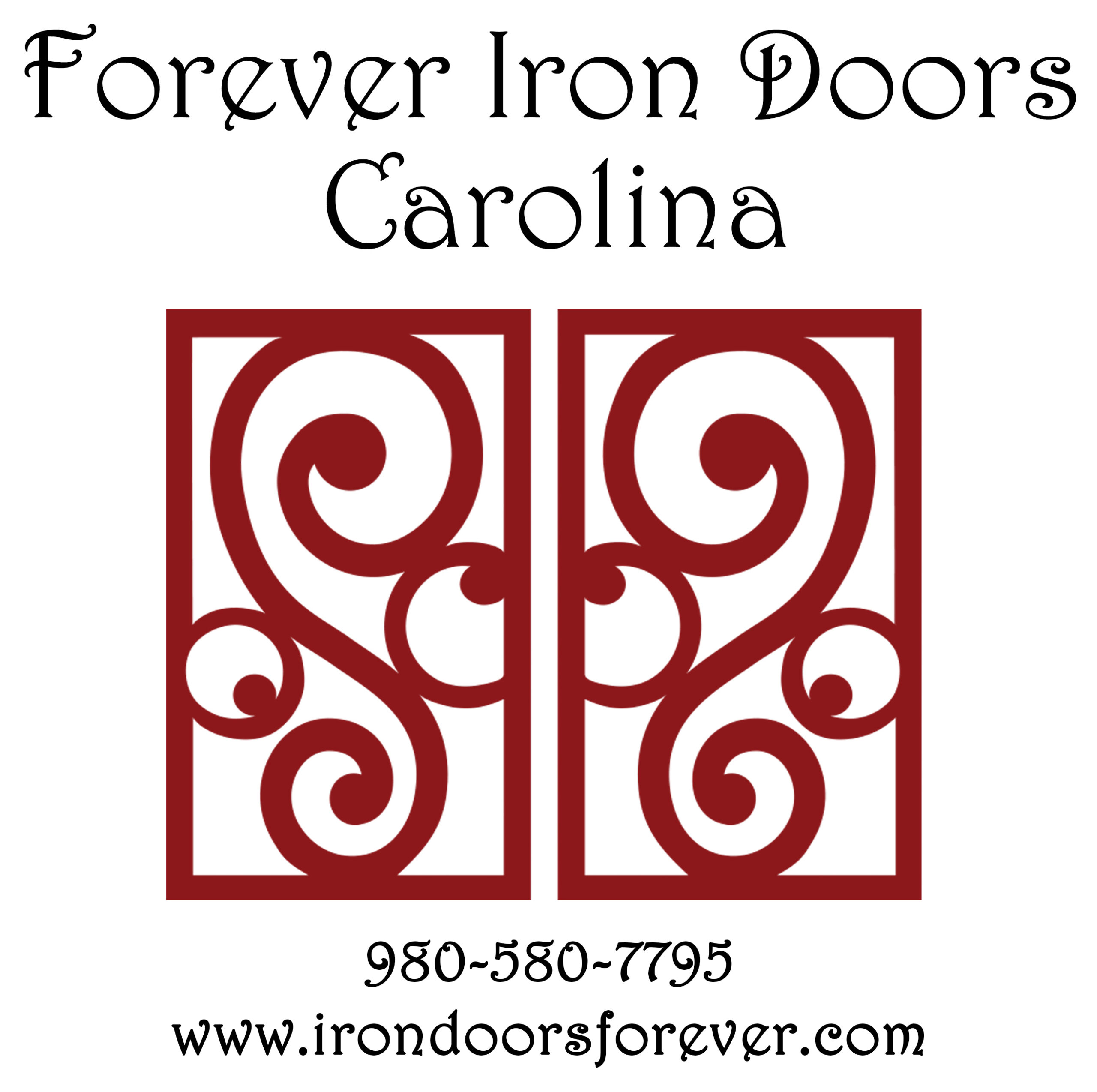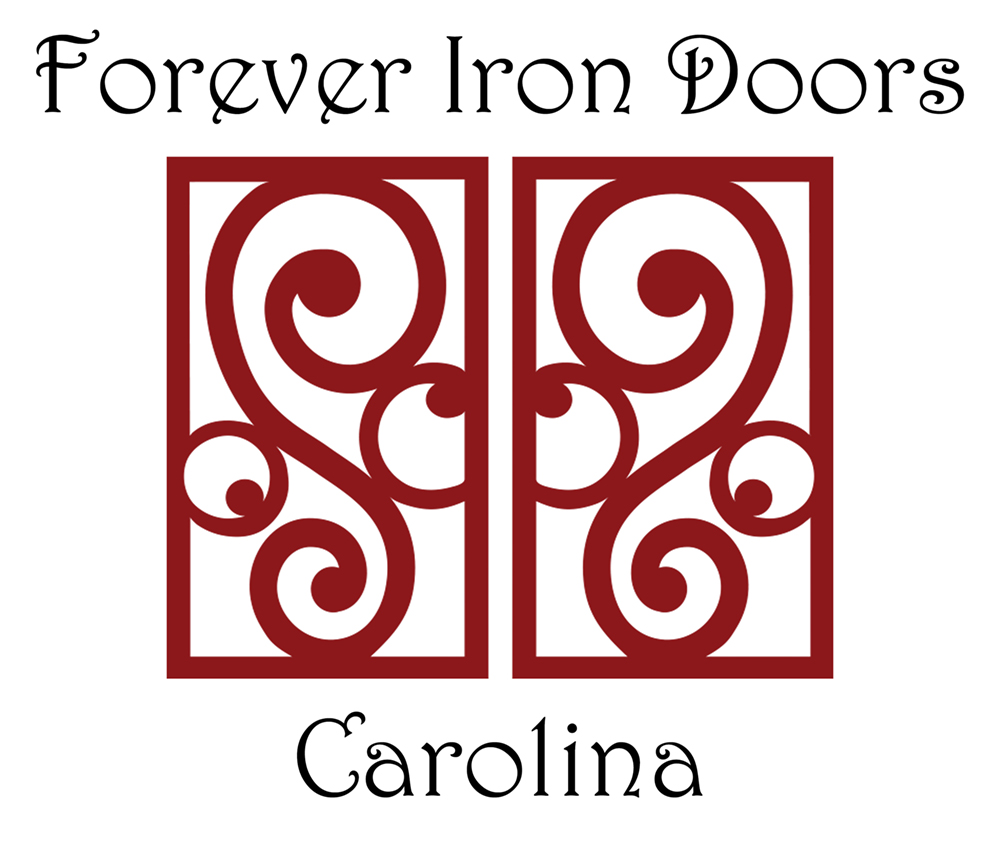When selecting hinges for outdoor iron doors, durability, functionality, and weather resistance are critical. Here’s what you need to know:
- Measure Your Door: Determine the height, width, thickness, and weight of your door. Heavier doors may need extra or heavy-duty hinges.
- Hinge Materials: Stainless steel and bronze are excellent for resisting rust and wear. Brass and galvanized steel work in moderate climates, while aluminum is lightweight but less durable for heavy doors.
- Protective Coatings: Powder coating, hot-dip galvanizing, and ceramic coatings add longevity by shielding hinges from moisture, scratches, and UV damage.
- Hinge Types: Butt hinges suit standard doors, pivot hinges handle heavier designs, and strap hinges combine support with decorative appeal. Continuous hinges provide maximum support for tall or heavy doors.
- Security Features: Look for non-removable pins and weather-sealing features for added safety and durability.
- Installation Tips: Proper alignment and spacing (e.g., 7 inches from the top, 11 inches from the bottom) ensure smooth operation and weight distribution.
Quick Comparison of Hinge Materials
| Material | Corrosion Resistance | Best Use Case | Cost |
|---|---|---|---|
| Stainless Steel | Excellent | Coastal, high humidity | High |
| Bronze | Very High | All climates | High |
| Brass | Good | Moderate humidity | Medium |
| Galvanized Steel | Fair | Dry climates | Low |
| Aluminum | Moderate | Lightweight doors | Medium |
Choosing the right hinges ensures your door remains secure, functional, and low-maintenance over time.
Understanding Door Specifications for Hinge Selection
Getting the right hinges for your iron door starts with precise measurements and a clear understanding of its weight and configuration. These details help you avoid costly mistakes and ensure your door operates smoothly. Let’s break down how to measure your door and assess its hinge requirements.
Measuring Door Dimensions and Weight
First, measure your door’s height and width. You can do this with direct measurements or by referencing the manufacturer’s specifications. These dimensions are essential for choosing hinges that can properly support the door.
Next, check the door’s thickness. Iron doors are typically thicker than standard wooden doors, and this extra bulk can affect hinge compatibility and alignment. Measure the thickness at multiple points to account for any inconsistencies.
Weight is another key factor. The weight of an iron door depends on its size, design details, and any decorative elements like glass panels. Make sure to verify the door’s weight and select hinges that can handle a higher load. For especially heavy or custom doors, you may need to weigh the door professionally. If your door includes ornate details or glass, consider using commercial-grade hinges to ensure proper support.
Determining Door Type and Number of Hinges Needed
For single doors, hinges should be evenly spaced to distribute the load properly. Always follow the manufacturer’s guidelines for hinge placement.
Double doors come with their own challenges, as both leaves must align perfectly. Each door in a double-door setup requires its own set of hinges. Misaligned hinges can create gaps, which may compromise security and weather resistance.
For heavier or custom doors, adding extra hinges can help distribute the load more evenly. This is especially important in areas where the door experiences frequent swinging or movement.
Also, confirm the door’s swing direction – whether it opens to the right or left. If security is a concern, opt for hinges with non-removable pins or interlocking tabs for added protection.
Finally, think about how the door will be used. High-traffic doors, for example, are better suited to hinges with enhanced bearings, like ball-bearing hinges, which are designed to handle frequent use. Environmental factors are also important. Doors exposed to strong winds, salty coastal air, or extreme temperature changes should be equipped with hinges built for durability and strength under such conditions.
Selecting Corrosion-Resistant Materials
Outdoor iron doors are constantly exposed to a variety of weather conditions – rain, snow, humidity, and temperature changes – all of which can wear down their hinges over time. To ensure durability and long-lasting performance, it’s crucial to choose the right corrosion-resistant hinge material. Once the base material is selected, adding a protective coating can further extend its lifespan.
Comparing Common Hinge Materials
The choice of hinge material plays a key role in resisting environmental stress and maintaining functionality for outdoor iron doors.
Stainless Steel:
Grade 316 stainless steel is known for its exceptional resistance to corrosion, making it an excellent choice for coastal areas. While it comes with a higher upfront cost, its durability often offsets the investment.
Brass Hinges:
Brass hinges develop a natural patina over time, adding charm to their appearance. Marine-grade brass, which contains more copper, performs well in humid environments but may require more upkeep in harsher conditions.
Galvanized Steel:
This budget-friendly option uses a zinc coating to prevent rust. It works best in dry climates but becomes prone to corrosion once the coating is damaged.
Bronze Hinges:
Bronze hinges are highly resistant to extreme weather and temperature fluctuations, making them a reliable choice for all climates. They also complement traditional iron door designs, though they tend to be pricier.
Aluminum Hinges:
Aluminum is lightweight and naturally resistant to corrosion. However, it may not support the weight of heavier iron doors as effectively as stainless steel or bronze, placing it in the mid-range for cost and strength.
Here’s a quick comparison of these materials:
| Material | Corrosion Resistance | Relative Cost | Best Climate | Durability |
|---|---|---|---|---|
| 316 Stainless Steel | Excellent | Higher | Coastal & Versatile | Long-lasting |
| Marine Brass | Very Good | Moderately High | Moderate Humidity | Reliable |
| Galvanized Steel | Fair | Lower | Dry | Moderate |
| Bronze | Excellent | Moderately High | All Climates | Very Long-lasting |
| Aluminum | Fair | Moderate | Moderate Climates | Fair |
Protective Coatings for Iron Hinges
Even the most durable materials benefit from a protective coating, which shields hinges from scratches, chipping, and weather-related damage.
Powder Coating:
This finish is tough, chip-resistant, and effective across a range of temperatures, providing solid protection in various environments.
Zinc Plating:
Zinc plating offers sacrificial protection, meaning it corrodes before the base metal does. While effective in moderate humidity, it doesn’t hold up as well in salty or coastal conditions.
Hot-Dip Galvanizing:
This process involves dipping the hinge in molten zinc, creating a thicker, more uniform coating that lasts longer than standard zinc plating.
Ceramic Coatings:
Ceramic coatings are a premium option designed for extreme weather. They resist UV rays, temperature swings, and chemical exposure, significantly extending hinge life despite their higher cost.
When choosing protective coatings, consider the demands of your specific environment:
- Coastal Areas: Use materials and coatings designed for marine conditions to withstand salt air.
- Humid Climates: Pair stainless steel or brass with a sturdy powder coating to minimize moisture damage.
- Desert Regions: Opt for materials and coatings that remain stable under high UV exposure and extreme temperature variations.
The thickness of the coating also matters. Standard coatings work well for everyday conditions, but thicker, heavy-duty layers provide extra durability. Just remember, overly thick coatings can sometimes affect hinge movement, so balance is key.
Choosing the Right Hinge Type for Outdoor Iron Doors
The type of hinge you choose for your outdoor iron door plays a big role in how it functions, how long it lasts, and how secure it is. Each hinge type is designed with specific weights, uses, and styles in mind. Understanding these options will help you pick one that meets both your practical needs and aesthetic preferences.
Overview of Common Hinge Types
Butt Hinges are a classic option for outdoor iron doors. They consist of two rectangular plates connected by a pin running through interlocking knuckles. These hinges sit flush with the door and frame, creating a neat look when the door is closed. They’re a great fit for standard swing doors and can handle significant weight when correctly sized. Heavy-duty versions with ball bearings reduce friction and wear, making them perfect for doors that see a lot of use. While reliable and straightforward, they require precise installation for proper alignment.
Pivot Hinges are designed to support the door from the top and bottom, evenly distributing the weight. This makes them ideal for heavy or oversized iron doors. Pivot hinges also offer a sleek, modern appearance since they’re mostly hidden. However, they need specialized preparation and professional installation to ensure they function properly.
Strap Hinges are both functional and decorative. They extend across the door, offering extra support by spreading stress over multiple mounting points. Their bold design makes them a popular choice for rustic, traditional, or Mediterranean-style homes. The long leaves also make installation more forgiving, as they allow for easier adjustments.
Spring Hinges are built for self-closing doors, making them a smart choice for security gates, pool enclosures, or any entrance where automatic closure is important. These hinges use internal springs to close the door, eliminating the need for a separate door closer. While they can be pricier than standard hinges, their convenience and functionality make them worth considering for security-focused applications.
Continuous Hinges, also known as piano hinges, run the entire length of the door. This design provides maximum support and evenly distributes the door’s weight. They’re particularly useful for tall or unusually shaped iron doors, where standard hinges might cause stress points. Continuous hinges also enhance security by minimizing gaps along the door’s edge. Installation requires careful measurement and cutting, but the result is smooth operation and long-lasting durability.
Comparison Table of Hinge Types
| Hinge Type | Best For | Weight Capacity | Visibility | Installation Complexity | Relative Cost |
|---|---|---|---|---|---|
| Butt Hinges | Standard doors, frequent use | High (with ball bearings) | Minimal when closed | Moderate | Low to Moderate |
| Pivot Hinges | Extra-heavy doors, modern design | Very High | Nearly invisible | High | High |
| Strap Hinges | Decorative doors, rustic styles | Moderate to High | Highly visible | Low to Moderate | Moderate |
| Spring Hinges | Security gates, self-closing doors | Moderate | Minimal | Moderate | Moderate to High |
| Continuous Hinges | Tall doors, maximum security | Very High | Visible along full edge | High | High |
When deciding on a hinge type, think about how the door will be used. For entry doors that experience heavy traffic, ball-bearing butt hinges or pivot hinges are excellent choices because they handle frequent use without wearing out. On the other hand, decorative gates or secondary entrances may benefit from strap hinges, which combine functionality with a stylish appearance.
The direction the door swings is another factor to consider. Butt hinges work well for both inward and outward swings, but certain specialty hinges may perform better depending on the configuration. Outward-swinging doors, for instance, are more exposed to weather, making hinge material and protective coatings especially important.
Also, think about maintenance needs. Butt hinges with removable pins make it easy to take the door off for repairs or refinishing. In contrast, pivot hinges and continuous hinges often require more effort to remove, which could increase long-term maintenance costs.
Finally, security is an important consideration. Continuous hinges offer the highest level of security because their full-length design eliminates gaps. Standard butt hinges with non-removable pins also provide solid protection for most residential doors. While decorative strap hinges may be less secure due to their surface-mounted design, high-quality versions with proper fasteners can still offer reliable security for most homes.
sbb-itb-cd90297
Evaluating Finishes and Functional Features
When it comes to outdoor iron doors, the finish you choose plays a crucial role in both appearance and durability. A good finish not only enhances the look of your door but also provides a layer of protection against rust and harsh weather conditions. It’s a combination of style and resilience that ensures your door stands the test of time.
Protective Finishes for Outdoor Hinges
Here are some popular finish options designed to protect and enhance outdoor hinges:
- Powder Coating: This tough, chip-resistant finish is perfect for doors that see heavy use.
- Hot-Dip Galvanizing: Adds a zinc coating that protects the metal underneath, even if the surface is scratched.
- Oil-Rubbed Bronze: Offers a classic look while hiding minor scratches, though it may need occasional maintenance.
- Stainless Steel Finishes: Naturally resistant to corrosion, these finishes are ideal for areas exposed to moisture or salty air.
- Black Oxide Coating: Provides a sleek, dark finish with moderate protection, all while maintaining precise hinge dimensions.
When selecting a finish, think about the environmental conditions your door will face and how you want it to look. A well-chosen finish can handle the elements while complementing your door’s overall design.
Functional Features for Better Performance
Finishes may protect and beautify, but functional features are what take hinge performance to the next level. Here are a few key features to consider:
- Ball Bearing Systems: These reduce friction, ensuring your door operates smoothly over time.
- Adjustable Tension Springs: Let you control the closing speed and force of self-closing hinges to suit your preferences.
- Non-Removable Pins: Add an extra layer of security by preventing unauthorized disassembly.
- Grease Fittings: Make it easy to lubricate hinges without the hassle of taking them apart.
- Lift-Off Capability: Simplifies door removal for maintenance or refinishing without dismantling the entire hinge assembly.
- Weather Sealing Features: Help keep water and debris out of the hinge mechanism, extending its lifespan.
Installation and Maintenance Tips for Hinges
Installing hinges correctly is the key to ensuring your outdoor iron door operates smoothly for years to come. A proper installation process not only protects your investment but also guarantees reliable performance, no matter the weather. Here’s a step-by-step guide to help you get it right.
Best Practices for Hinge Installation
The first step in a successful installation is preparation. Start by examining your outdoor iron door and determining the exact placement for the hinges. Measure the dimensions of your door carefully and choose hinges that are designed to support its size and weight.
Gather all the tools you’ll need before getting started. This includes the iron hinges, screws specifically recommended for iron doors, a screwdriver or drill with the correct bit, measuring tape, a pencil, a chisel, and a hammer. If you’re replacing old hinges, remove them carefully to avoid damaging the door or its frame.
Lay the door flat on a stable surface and mark the hinge positions. A good rule of thumb is to place one hinge 7 inches from the top, another 11 inches from the bottom, and a third hinge centered between the two. This arrangement helps evenly distribute the door’s weight, ensuring smooth and balanced operation. Once you’ve marked the spots, position each hinge plate against the marks and trace their outlines. Use a chisel and hammer to create shallow recesses (mortises) to the exact depth of the hinge plates. Work carefully to avoid cutting too deep.
Next, secure the hinge plates in their mortises. Pre-drill the screw holes to prevent splitting, then attach each hinge using two screws initially. Tighten the screws evenly to ensure proper alignment. A self-centering drill bit can be especially helpful for achieving precision during this step.
Once the hinges are firmly attached to the door, use it as a guide to mark the corresponding hinge positions on the door frame. This ensures perfect alignment. Hold the door in its final position within the frame, using door hinge shims to maintain the correct height. Then, mark the frame where the hinges will be installed. This method guarantees a precise fit and smooth operation.
Making the Right Choice for Your Outdoor Iron Door Hinges
Choosing outdoor iron door hinges means finding the right balance between durability, functionality, and style. Every detail – from the material to the finish – plays a role in how well the hinges perform over time. Outdoor hinges need to endure temperature changes, moisture, and daily wear while keeping their strength and visual appeal intact.
Materials and finishes are key starting points. Stainless steel hinges are a top choice for areas with high humidity or near the coast, thanks to their resistance to corrosion. For more traditional doors, heavy-duty hinges with protective coatings provide both strength and longevity. Always pick materials that match your door’s construction and can handle the local weather. Finishes are just as important – they protect the hinges and add to the overall look. Powder-coated finishes are great for weather resistance and come in a variety of colors, letting you either match the door or create a bold contrast. If you prefer a more classic touch, finishes like oil-rubbed bronze or antique copper can add charm, while modern black or galvanized finishes are perfect for contemporary designs.
Functionality matters too. Don’t let appearance be your only focus – think about how the hinges will perform. Ball bearing hinges, for example, reduce friction, making them ideal for extending the life of both the hinges and the door. Self-closing hinges are a smart choice for added convenience and security. For heavier iron doors, adding an extra hinge can help distribute the weight more evenly, ensuring smooth operation.
If you’re working with custom wrought iron doors, professional advice can make all the difference. Companies like Forever Iron Doors Carolina specialize in matching hinges to custom designs, ensuring proper weight distribution and performance. Professional installation also helps guarantee that all components work seamlessly together.
Budget planning is another important factor. While high-quality hinges may cost more upfront, they often save money in the long run by reducing the need for frequent replacements and maintenance. Think about the costs of upkeep and the hassle of dealing with hinge failures when making your decision.
Finally, consider the installation environment. If your door is exposed to direct sunlight, UV-resistant finishes are a must. For shaded or damp areas, look for moisture-resistant options. High-traffic commercial doors may need heavy-duty hinges, while standard-duty ones are often sufficient for residential use without sacrificing performance.
FAQs
What should I consider when choosing hinges for outdoor iron doors?
When selecting hinges for outdoor iron doors, it’s important to prioritize strength, material quality, and practicality. Look for hinges crafted from rust-resistant materials such as stainless steel, brass, or aluminum, as these can handle exposure to outdoor elements. In regions with high humidity or extreme weather, 304 or 316 stainless steel offers excellent reliability.
Ensure the hinge size and weight capacity match your door’s dimensions and weight. This not only guarantees smooth operation but also enhances durability over time. You might also want to choose a hinge finish that complements the door’s design while adding an extra layer of protection against wear. By keeping these considerations in mind, you can find hinges that are both sturdy and stylish.
What hinge materials are best for outdoor iron doors in different weather conditions?
The durability of hinge materials can differ greatly depending on the weather they face. Stainless steel hinges, especially grades 304 and 316, stand out for their strength and ability to resist rust, corrosion, and extreme temperatures. This makes them a solid pick for outdoor iron doors, particularly in humid regions or coastal areas.
In contrast, hinges made from aluminum or plastic tend to wear out more quickly when subjected to harsh weather conditions over time.
To ensure your outdoor iron door remains functional and reliable, it’s crucial to opt for hinges that can handle your local climate while also matching the door’s sturdiness and style.
Why should you use protective coatings on hinges for outdoor iron doors?
Using protective coatings on hinges is a smart way to guard them against rust, corrosion, and moisture – issues that often arise with outdoor installations. These coatings help extend the life of the hinges while keeping them working smoothly, even in tough weather conditions. Choosing coated hinges ensures your outdoor iron doors remain both durable and visually appealing for years.



